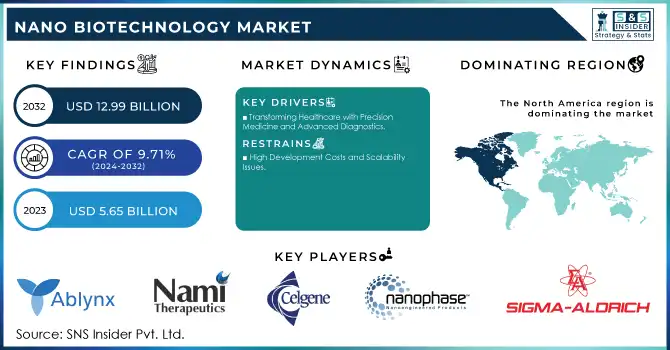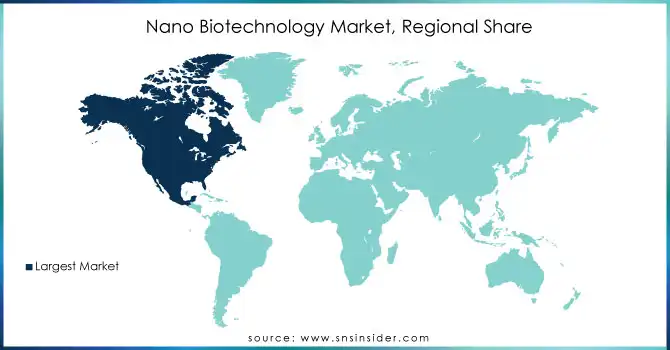Nano Biotechnology Market Report Scope & Overview:

Get more information on Nano Biotechnology Market - Request Sample Report
The Nano Biotechnology Market Size was valued at USD 5.65 billion in 2023 and is expected to reach USD 12.99 billion by 2032 and grow at a CAGR of 9.71% over the forecast period 2024-2032.
The nano biotechnology market is revolutionizing healthcare through its applications in diagnostics, therapeutics, and public health innovations. A prominent example of its transformative impact is the use of lipid nanoparticles in developing mRNA vaccines during the COVID-19 pandemic, enabling high efficacy and rapid global deployment. These nanoparticles are now being explored for vaccines against infectious diseases and cancers.
In diagnostics, quantum dots and nanosensors have advanced early disease detection. Nanosensors, for instance, can detect biomarkers for diseases such as cancer at incredibly low concentrations, allowing for earlier intervention and improved patient outcomes. Additionally, nano-imaging technologies are enhancing the precision of medical imaging, leading to better diagnostic accuracy. Drug delivery systems have also seen significant innovation. Nanocarriers such as dendrimers, liposomes, and polymeric nanoparticles enable targeted delivery of drugs, reducing side effects and improving efficacy. For example, liposomal formulations like Doxil have successfully targeted tumor cells while sparing healthy tissues in cancer treatment.
In public health, nanotechnology is being applied to create antimicrobial nanocoatings for food packaging, increasing safety and shelf life. Similarly, nanotechnology-based water purification systems are providing safe drinking water in regions with limited resources, addressing critical global health challenges. However, challenges remain, including high costs of development, regulatory complexities, and scalability issues. Continued collaboration between academia, industry, and policymakers is essential to overcome these barriers and accelerate the integration of nano biotechnology into mainstream healthcare.
Market Dynamics
Drivers
-
Transforming Healthcare with Precision Medicine and Advanced Diagnostics
The nano biotechnology market is driven by multiple factors that highlight its transformative potential in healthcare and beyond. One primary driver is the increasing demand for targeted and efficient drug delivery systems. Nanocarriers, such as liposomes and polymeric nanoparticles, enable precision medicine by delivering drugs directly to affected cells, reducing side effects, and improving therapeutic outcomes. This technology has proven particularly effective in oncology and neurology, where traditional therapies often fall short. Another significant driver is advancements in diagnostic technologies. Nanosensors and quantum dots are enabling early detection of diseases such as cancer and infectious illnesses, providing higher sensitivity and accuracy than conventional methods. These innovations facilitate timely interventions, enhancing patient survival rates.
The global surge in chronic diseases, including cardiovascular and metabolic disorders, further propels the adoption of nano biotechnology. The ability to develop nano-enabled therapeutics tailored to complex conditions positions this technology as a cornerstone of modern medicine. Moreover, its application in vaccine development, as demonstrated during the COVID-19 pandemic with lipid nanoparticle-based mRNA vaccines, underscores its critical role in addressing public health emergencies. This success has spurred further research into nano-based vaccines for infectious diseases like HIV and influenza. Growing investments in research and development, coupled with supportive government initiatives, are also accelerating market growth. Initiatives aimed at fostering innovation in nanotechnology are particularly strong in regions like North America and Europe, while Asia-Pacific emerges as a lucrative market due to expanding biotechnology infrastructure.
Restraints
-
High Development Costs and Scalability Issues
Nano-biotechnology involves sophisticated processes and materials, leading to significant research, development, and production costs. Scaling up these technologies for widespread application remains a challenge, particularly for startups and small enterprises with limited resources.
-
Regulatory and Safety Challenges
The lack of standardized regulatory frameworks and comprehensive safety evaluations for nano-scale materials poses a barrier to market growth. Concerns over potential environmental and health impacts of nanoparticles further complicate approval processes, slowing the adoption of new technologies.
Key Segmentation
By Application
In 2023, the pharmaceuticals segment accounted for the largest share of the nano biotechnology market. This dominance can be attributed to the increasing demand for targeted drug delivery systems, where nanomaterials are used to enhance the efficacy and precision of treatments. Nanotechnology enables drugs to be delivered directly to the affected areas, such as cancer cells, reducing side effects and improving patient outcomes. Furthermore, the success of mRNA vaccines during the COVID-19 pandemic has further accelerated investment in pharmaceutical nanotechnologies. Nano-formulations, such as lipid nanoparticles and dendrimers, are now pivotal in the development of new treatments for chronic diseases, cancer, and genetic disorders.
The medical device segment is expected to grow at the fastest rate in the coming years. The incorporation of nano-engineered materials in medical devices, such as biosensors, diagnostic tools, and wound care materials, is driving this growth. For example, nano-enabled wound dressings are being developed to improve healing times and reduce infection rates, while nano-sensors are enhancing the accuracy and sensitivity of diagnostic devices. The shift towards minimally invasive surgeries and point-of-care diagnostics, coupled with growing healthcare demands globally, is contributing to the robust growth of this segment.
By Therapeutics
Cardiac therapies led the therapeutics segment in 2023, driven by the increasing prevalence of heart diseases and advancements in nanotechnology that improve drug delivery for cardiovascular treatments. Nanoparticles are being used to deliver drugs directly to the heart, ensuring higher bioavailability and reducing systemic side effects. Additionally, nano-based diagnostic tools are enhancing the detection and monitoring of cardiovascular diseases, contributing to better management and outcomes. These innovations are expected to continue growing in the coming years as healthcare systems globally focus on improving heart disease treatments.
Orthopedic therapies are emerging as the fastest-growing therapeutic area within nano biotechnology. The use of nanomaterials in bone regeneration and tissue repair has led to innovative solutions for treating fractures, arthritis, and bone-related conditions. Nanoparticles such as hydroxyapatite are being incorporated into bone grafts and implants, promoting faster healing and improving compatibility with natural bone. This segment is gaining traction due to the aging global population, increasing incidence of musculoskeletal disorders, and advancements in nanotechnology that enhance the regenerative capabilities of orthopedic treatments.
Regional Analysis
North America continued to dominate the nano biotechnology market, driven by its advanced research infrastructure, high healthcare standards, and robust pharmaceutical industry. The U.S. leads in nano-based drug delivery systems and medical devices, supported by strong government funding and institutions like the National Institutes of Health (NIH). These factors make North America a hotspot for innovations in areas like cancer treatment and personalized medicine, particularly within the pharmaceutical and medical device sectors. The increasing emphasis on biotech research in North America further strengthens its leadership.
In Europe, nations like Germany, France, and the UK are investing heavily in nano biotechnology, particularly in diagnostic tools and medical devices. Europe has a strong focus on regulatory standards, which has spurred advancements in applications such as nano-based diagnostics and vaccines. The European Union also funds various nano biotechnology projects, enhancing collaboration across countries and fostering innovation. The demand for eco-friendly and sustainable nanomaterials is also growing, with the region seeking applications in agriculture and environmental health.
The Asia-Pacific region is witnessing rapid growth, driven by increasing healthcare needs and government initiatives to support biotech industries. Countries such as China, Japan, and India are at the forefront of adopting nano biotechnology for drug development and agricultural applications. The rising demand for personalized medicine and improved healthcare solutions in these regions is accelerating the adoption of nano-tech innovations. Additionally, the expanding biotech ecosystem in Asia-Pacific is attracting significant global investment, further boosting regional growth.

Need any customization research on Nano Biotechnology Market - Enquiry Now
Key Players
-
Ablynx - Nanobodies, Vobarilizumab
-
Nami Therapeutics - NanoVax
-
Celgene Corporation - Abraxane
-
Nanophase Technologies Corporation - Nanoderm
-
Sigma-Aldrich - Nanoparticles for drug delivery, biosensors
-
SkyePharma Pharmaceuticals - DepoCyte
-
Nanobiotix - Nanomedicine-based treatments
-
Nano Bridging Molecules SA - Nanoformulations
-
XanTecbioanalytics GmbH - Bioanalytical nanosensors
-
Johnson & Johnson - Nano-based medical devices, drug delivery systems
-
Abbott Laboratories - Nanotechnology-based diagnostic products
-
Novartis AG - Nanomedicine therapies for cancer, ophthalmology
-
Dabur Pharma - Nanoemulsions, drug delivery systems
Recent Development
In Sept 2024, scientists at NIAB developed a groundbreaking diagnostic kit for detecting antibiotics in animal food samples, a major advancement in food safety and antimicrobial resistance. Along with this, they introduced a nano-mineral biocapsule that enables the targeted delivery of personalized nutrients, drugs, antibiotics, and other bioactive molecules.
In Sept 2024, biotech firm NanoSyrinx successfully raised £10 million (USD 12.2 million) to further develop its innovative nano syringe delivery platform. The platform leverages naturally occurring "nano syringes" engineered to selectively deliver peptide and protein payloads directly into the cytosol of targeted cells.
| Report Attributes | Details |
|---|---|
| Market Size in 2023 | US$ 5.65 billion |
| Market Size by 2032 | US$ 12.99 billion |
| CAGR | CAGR of 9.71% From 2024 to 2032 |
| Base Year | 2023 |
| Forecast Period | 2024-2032 |
| Historical Data | 2020-2022 |
| Report Scope & Coverage | Market Size, Segments Analysis, Competitive Landscape, Regional Analysis, DROC & SWOT Analysis, Forecast Outlook |
| Key Segments | • By Application (Pharmaceuticals, Medical devices, Medical Research, Food and Agriculture) • By Therapeutics (Dental therapies, Cardiac Therapies, Orthopedic therapies, Others) |
| Regional Analysis/Coverage | North America (US, Canada, Mexico), Europe (Eastern Europe [Poland, Romania, Hungary, Turkey, Rest of Eastern Europe] Western Europe] Germany, France, UK, Italy, Spain, Netherlands, Switzerland, Austria, Rest of Western Europe]), Asia Pacific (China, India, Japan, South Korea, Vietnam, Singapore, Australia, Rest of Asia Pacific), Middle East & Africa (Middle East [UAE, Egypt, Saudi Arabia, Qatar, Rest of Middle East], Africa [Nigeria, South Africa, Rest of Africa], Latin America (Brazil, Argentina, Colombia, Rest of Latin America) |
| Company Profiles | Ablynx, Nami Therapeutics, Celgene Corporation, Nanophase Technologies Corporation, Sigma-Aldrich, SkyePharma Pharmaceuticals, Nanobiotix, Nano Bridging Molecules SA, XanTecbioanalytics GmbH, Johnson & Johnson, Abbott Laboratories, Novartis AG, Dabur Pharma. |
| Key Drivers | • Transforming Healthcare with Precision Medicine and Advanced Diagnostics |
| Restraints | • High Development Costs and Scalability Issues • Regulatory and Safety Challenges |

